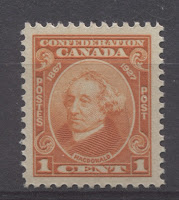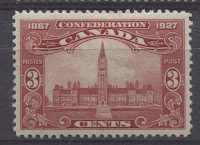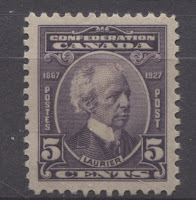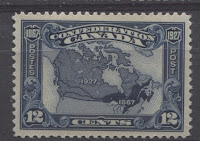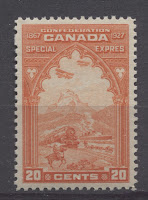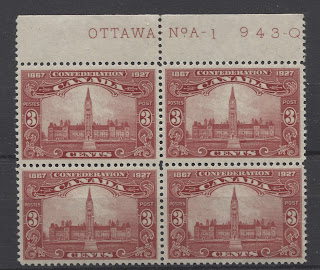Overview
This neat little commemorative set was issued on June 29, 1927, the same day as the Historical Issue. It is one of those sets that most collectors buy for their albums and never think much about. Indeed, Unitrade contains really just one page of listings and so it seems to be a set that does not afford much opportunity for specialization. However, nothing could be further from the truth. In fact, there are several points of interest around which a specialized collection could be formed as we shall see. These include:
- Shade variations on all values except possibly the 12c, as I have not seen any shade variations on that value.
- Differences in both the thickness of the paper and visibility of mesh.
- Some plate flaws can be found, though these are scarce.
- The era of First Day Covers is generally recognized to have begun with this issue, and so it is possible to look for different cachets.
- Most of the stamps take CDS cancels beautifully, so a cancel collection would be very challenging and attractive.
- All of the stamps were printed from at least 2 plates, with the 1c being printed from 6 plates and the 2c green being printed from 14 plates! Collecting plate blocks of all known plates would be a real challenge, especially for VFNH.
- Imperforate pairs exist for all values.
- A large range of proofs exist as well. While these are not cheap, they are much more affordable than any proof material that came before this issue, with most items being in the $300-$3,000 range.
- All values exist in both vertical pairs imperforate horizontally and horizontal pairs imperforate vertically. Plate blocks like this exist for the 20c special delivery stamp, E3.
- Lots of interesting and scarce covers can be sought, some franked with just these stamps, and others with combinations of this issue and the Scroll Issue.
- The era or airmail starts with this issue, and this issue is often found on first flight covers as well as semi-official airmail covers.
- The 1c orange can be found with 4 styles of precancel.
- Two stamps exist imperf between the stamp and right margin: the 3c, and 12c, while the 20c exists from the top margin imperf. between the stamp and the margin.
- All values exist with up to 8 different types of 5-hole OHMS perforation. They are all very scarce.
When you combine all of the above factors and form a specialized collection you can still spend a lot of money, but over time. In my opinion, this is an ideal issue for someone who cannot afford to pay more than $300-$500 for a single item, or that much per month, or per quarter. Even though some proofs will cost $3,000 or so, a collector with a modest budget could save up for that over a reasonable period, like a year. The used stamps are inexpensive enough that a collector of modest means could occupy themselves with the cancels while waiting for the better items to come along.
The stamps were all designed by Herman Herbert Swartz. Edwin H. Gunn engraved all the designs except for the 3c, which was engraved by Harold Osborn. The printer was the Canadian Bank Note Company.
The Stamp Designs and Issue Quantities
1c orange Sir John A Macdonald 2c green Fathers of Confederation
148,034,000 issued 333,757,000 issued
3c carmine-red Parliament buildings 5c purple Wilfred Laurier
15,431,000 issued 26,627,000 issued
12c bright indigo map of Canada 20c red orange - allegory of transport
7,492,000 issued 671,400 issued
As you can see, the issue quantity for the 20c value is relatively low. This is also a difficult stamp to find well centered and NH, so in my opinion it is a highly under-rated stamp, especially in very fine used condition. Surprisingly though, even the common stamps like the 2c are very difficult to find very fine NH with nice margins. From my experience, the 5c and the 12c are the easiest stamps to find VFNH, followed by 1c and 3c, and then finally the 2c and 20c, which are the toughest by far. The average centering for this issue is fine and given that the stamps were printed in sheets of 100 and line perforated,very fine plate blocks in which all stamps are well centered and NH are very scarce and worth quite a bit more than the corresponding number of VFNH stamps.
Shades
Although subtle, there are several shades that I have found on the stamps of this issue. The largest variation seems to be on the 1c, though I have generally found at least two shades of every value except for the 12c:
- 1c reddish orange
- 1c deep reddish orange
- 1c pale reddish orange
- 1c dull red orange
- 1c deep orange
- 1c orange
- 2c deep green
- 2c deep dull yellowish green
- 2c dull yellowish green
- 3c deep carmine red
- 3c brownish carmine red
- 3c carmine red
- 5c deep slate lilac
- 5c deep dull purple
- 5c dull purple
- 12c bright indigo
- 20c orange-red
- 20c deep bright orange-red
- 20c deep dull orange red
These shade variations are probably best collected as blocks of four, as they will be much more obvious that way. However, even singles will probably be sufficient if they are mounted next to one another on a page.
Plate Flaws
Unitrade does not currently list any constant plate flaws on any of the values. I am not sure if this is because none exist, or whether it is because no one has done a comprehensive study of existing sheets to identify them. I will say that plate flaws on this issue are scarce, largely because the plates used to print these stamps were very durable and were only in use a short time. Hans Reiche some years ago had published a small handbook in which he detailed plate flaws found on this and other issues of the 1930's. Unfortunately I do not have a list of these flaws, but can say that I have seen the following ones:
- 1c - large vertical crack appearing above Sir John A Macdonald's head.
- 3c - large dot on the roof of the parliament buildings, resembling a hole.
While these flaws may not be constant, I think they are still interesting and can be fun to look for.
Plate Blocks
Many plate blocks can be collected of this issue. Generally speaking there is only one position for each plate at the top of the sheet, though on the 2c, there are left (L) and right (R) positions. The size of the block is generally determined by the size of the inscription, with the 3c block above being 4 stamps and many others being either 6 or 8 stamps. The 20c comes in two positions: upper left and lower left:
- 1c comes in plates A1 through A6. All are blocks of 8.
- 2c comes in 19 plates: A1, 2, 3L, 3R, 4, 5, 6, 7L, 7R, 8L, 8R, 9, 10, 11L, 11R, 12, 13, 14. 15. most are blocks of 6, though 8R, 9, and 11L are blocks of 4.
- 3c comes in plates A1 through A3. A1 is a block of 4, while the others are blocks of 6.
- 5c comes in plates A1-A3 and all are blocks of 8.
- 12c comes in A1 and A2 and are blocks of 6.
- 20c comes in plate 1 UL and LL and are blocks of 6.
So the above list makes a basic collection of 36 blocks. If you collect the above shade variations, it can be expanded far beyond that number, though not so much that it becomes unmanageable.
Proof Material

The BNA Proofs website lists no fewer than 36 different proof items as follows:
- 7 essays consisting of the central portraits of the 1c and 5c all in black;
- 12 die proofs in various sizes of all values in issued colours;
- 12 trial colour proofs. With two exceptions these are all black. One example of the 3c is known in olive green, while the 1c is known in yellow. Generally they are either large size or stamp sized;
- 5 with specimen overprint - one of each value. The 1c is yellow, while the others are all issued colours.
According to the website, there are only between 1 and 5 known examples of each item, so at $300-$3,000 each, they are quite inexpensive, given their scarcity.
The full listing can be found at this link:
Imperforate Varieties and Part Perforate Varieties
There were 500 examples of each of the following varieties issued for each value:
- Imperforate completely.
- Imperforate horizontally.
- Imperforate vertically.
So there are at most only 250 pairs of each of these varieties in existence, making them modern day rarities. They only list between $140-$240 each depending on grade, making them one of the best bargains of the early modern era in my opinion.
Postal History
A wide variety of covers can be collected bearing either the stamps of this issue, or this issue in combination with either the Scroll Issue, or the Historical Issue. The first Scroll Issue stamps appear on October 17, 1928 and the set appears between that date and January 8, 1929. So technically, the period of use for this issue is between the following dates:
- 1c - June 29, 1927 to October 29, 1928;
- 2c - June 29, 1927 to October 17, 1928;
- 3c - June 29, 1927 to December 12, 1928;
- 5c - June 29, 1927 to December 12, 1928
- 12c - June 29, 1927 to January 8, 1929;
- 20c - June 29, 1927 to September 2, 1930.
The 1c will generally be found on unsealed printed matter, or in pairs on local letters and postcards. The 2c will be very common and found on local letters or postcards. The 3c value was issued to pay the Empire letter rate to the UK and for local letters weighing more than 1 ounce. and so it will generally be found used singly on those types of letters. The 5c would generally be found either in combination with the 3c to pay the non-UK letter rate of 8c, or it will be found in larger multiples on parcels or bulk mailing receipts, or in pairs or blocks to pay either the registration or special delivery fees. Finally the 12c value was issued to pay the registration plus postage on a local letter, so most of the covers found with this stamp will be single usages.
5-Hole OHMS Perfins
All values of this issue, except for the 20c special delivery exist with 5-hole OHMS perfin. There are up to 8 different positions:
- upright
- upright reversed
- inverted
- inverted reversed
- sideways right
- sideways right reversed
- sideways left
- sideways left reversed
I do not know which combinations exist for each value. Roy Wrigley published a small paperback catalogue of these issues back in the 1980's and it should still be possible to find a copy either on e-bay or with the specialized dealers of philatelic literature like Phil Bansner.
That brings me to the end of my post about this issue. Hopefully you can see that this issue provides plenty of scope for a specialized collection, especially when combined with the next issue, the Historical issue, which will be the subject of my next post.


